Playing guitar standing up can sometimes feel awkward and frustrating due to an issue called “neck dive”.
This guide will explain what guitar neck dive is and the 6 best methods you can use to fix it. The solutions can work on both guitar and bass to fix neck dive.
If you’re new to guitar, learn the part names of the guitar before reading this guide.
What is Guitar Neck Dive?
Guitar neck dive is when the headstock and neck of your guitar pull down while you play standing up. If you let go of your guitar while standing and you see your guitar neck swing down towards the ground, that’s neck dive.
In the below photos, you can see that when I take my hands off of my guitar while standing, the neck swings down toward the ground.

Notice that different guitars have different levels of neck dive. My blue headless guitar had zero neck dive, while my double neck guitar dropped like a stone to the floor as soon as I let go.
A combination of four things causes guitar neck dive:
- Weight distribution: the shape, hardware, and hardware used on your guitar will all affect the balance of the guitar and its center of gravity
- Headstocks: the weight of the headstock and tuning mechanisms all contribute to neck dive. Some headstocks are far heavier than others
- Strap button positions: the placement of the guitar strap buttons can cause the guitar to swing around
- Guitar strap: some guitar straps are slippery and make it easier for the neck to dive
It’s important to understand what specifically causes guitar neck dive because every guitar is different.
For example, in the above photos, you can see that my Telecaster (far left) had quite a bit of neck dive, despite the fact that it has a relatively light headstock. While guitars like the Gibson SG are notorious for neck dive due to the weight balance and heavy headstock.
The more neck dive a guitar has, the more noticeable and annoying it is. If you’re reading this guide, it’s probably because your guitar has enough neck dive that it’s becoming frustrating.
An important point to keep in mind is that any neck dive away from your preferred playing position is bad. For example, the position of the Telecaster in the above photo may not look like bad neck dive, but it is for me because it has moved quite far away from the position I prefer playing in. This means that what is considered a “bad” neck dive will differ between guitarists.
Neck dive on bass guitars is a common problem due to their large and heavy headstocks. This guide will give you 6 possible solutions to neck dive that can work on both guitar and bass.
Why Fixing Guitar Neck Dive Matters
Fixing guitar neck dive matters because it affects your playing technique. If you need to compensate for neck dive by tightly gripping the guitar or using your arm to anchor the guitar body in position, it can cause issues in your playing technique. You can even end up with injuries that hinder your playing over time.
As an extreme example, imagine trying to play this triple-neck monstrosity:
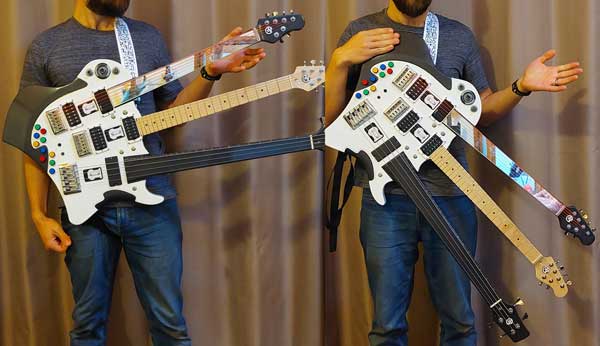
The photo on the right shows the neck dive when I use a normal guitar strap and the photo on the left shows the zero neck dive after I solved the problem (covered later).
As you can see, it has severe neck dive due to the sheer weight of the three necks and headstocks. As soon as I let go of the guitar, the three necks swing down toward the ground.
I built this guitar (inspired by Steve Vai’s Ibanez Hydra) and it was literally unplayable when standing up due to neck dive before I fixed it.
Trying to hold the guitar in position while standing was awkward and made it impossible to play properly.
Once I fixed the neck dive problem I was able to jump back and forth between the necks effortlessly because I didn’t need to try and compensate for neck dive.
While the neck dive in a regular guitar won’t be as bad as this example, it still affects your playing technique.
Some guitarists tense up their picking arm to clamp the guitar against their body while playing. Other guitarists need to constantly add extra pressure to the guitar neck to keep it upright.
Even if you don’t notice the compensations you’re making while playing, you will notice the difference when you play a guitar that has zero neck dive.
In short: fixing guitar neck dive matters because it improves your playing form and technique. It can also prevent long-term injuries in severe cases.
Have a think about the four causes of guitar neck dive (covered earlier) and how each one relates to your guitar. This will help you decide which of the solutions I cover in this guide will suit you.
Easiest Solution #1: Buy a Grippy Guitar Strap
As mentioned at the start of this guide, one of the four causes of guitar neck dive is the type of guitar strap you use.
Changing your guitar strap could be all that it takes to fix your guitar neck dive. It won’t solve the problem with every guitar, but it’s a good starting point.
Guitar Strap Material
Many guitar straps use a slippery material that freely slides on your shoulder.


The above guitar straps use smooth materials and are likely to make your guitar neck dive worse.
The guitar strap I used in the earlier photos feels like the same material used in car seatbelts. It feels very comfortable on my shoulder and makes it easy to reposition the guitar while standing, but the downside is that it makes it easier for the neck to dive.
If you’re currently using a guitar strap that easily slides against your shoulder, you might want to try using a grippy strap.
Leather and suede guitar straps are a great option because some of them have a grippy underside as shown below:
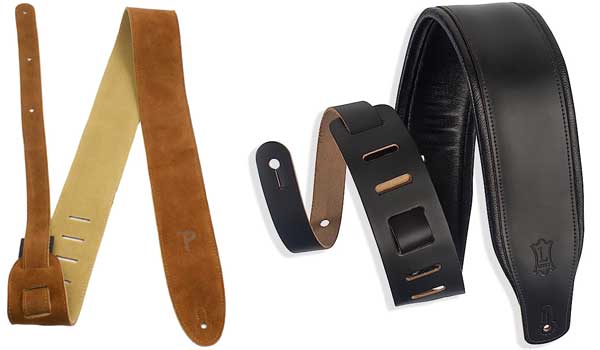

The suede guitar strap on the left (link to Amazon) has a grippy underside that helps prevent neck dive, while the leather strap on the right has a smooth underside that may or may not help.
You can see how grippy the suede backing on my StrapGraphics custom leather strap is in the below photo:
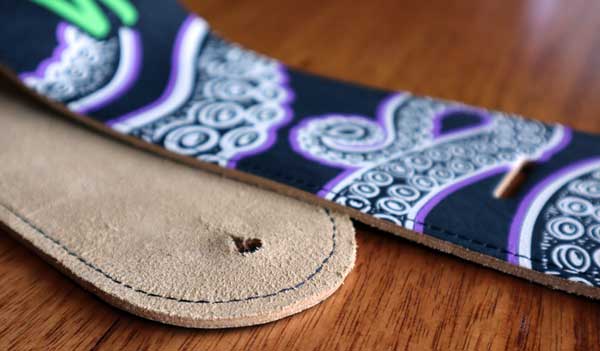

So make sure you check the underside of any strap you buy as not all leather straps will prevent neck dive.
If you’re searching online for guitar straps to prevent neck dive, use keywords such as: suede, anti-slip, or grip.
Guitar Strap Width
The width of the guitar strap also matters with neck dive.
A narrow guitar strap has less material to grip with, so it’ll be more likely to add to neck dive.
A wide guitar strap has more material to grip with, so it’ll be more likely to prevent neck dive.


If you haven’t tried a wide guitar strap before, they’re often comfier than narrow straps – especially with heavy guitars.
If you can find a wide and grippy guitar strap, it will give you the best prevention for neck dive possible.


As you can see in the above examples, there are plenty of different options for wide guitar straps.
Wide guitar straps are usually available at around 3-4″ (7.6 – 10.2 cm) wide in various materials. Long and wide straps are common for bassists.
Check out these wide guitar straps to get a better idea of the options available.
Compare the width of my 3.5″ custom leather guitar strap with suede backing to a typical 2″ polyester strap:


It should be obvious how the extra surface area of the leather strap helps the strap stay in place on your shoulder. When combined with a suede backing, neck dive can be completely solved with many guitars. Check out my review of the above custom guitar straps here to learn how to design your own guitar strap.
A wide and grippy guitar strap may not solve neck dive for every guitar or bass, but it will certainly help for the majority of guitars.
If your guitar neck still dives with a wide and grippy strap, don’t give up or throw the strap away. Keep the strap and use it in combination with one or more of the other methods covered below.
Solution #2: Add Grip to Your Guitar Strap
If you have a guitar strap that you don’t want to replace but it slips on your shoulder, you might want to try adding something grippy to it to help it stay on your shoulder and prevent neck dive.
The Guitar Gummy (link to Amazon) is designed with this idea in mind.
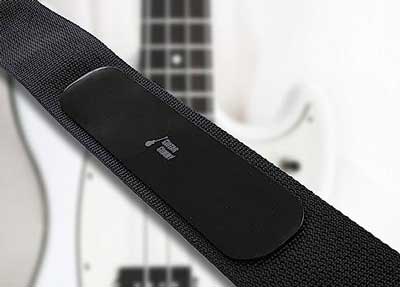

You stick it onto one side of your guitar strap, then it grips onto your shoulder to help prevent neck dive.
If you read the reviews, people have mixed results with this method. It works perfectly fine with some guitars but isn’t enough to work for every guitar.
Many guitarists have tried DIY solutions by sticking different materials onto their guitar straps. It works for some people, but not everyone.
Whether something like this works depends on which of the four causes are causing your neck dive. If your guitar has bad neck dive because of a heavy headstock or bad weight balance, you may find that adding something grippy to your strap won’t be enough.
This method will also have varying levels of success depending on what clothes you wear.
Solution #3: Add Balancing Weights
One simple solution that works for many guitars is to add some small weights to help balance the guitar.
The basic idea is to stick weights onto the back of your guitar or inside the electronics cavity to help tip the balance of the guitar away from the neck.
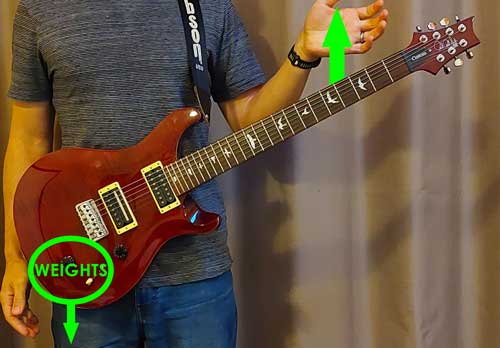

How well this method works depends on the current weight balance of your guitar and the position of any cavities in your guitar.
The easiest way to try this method out is to buy balancing weights used for wheel balancing (link to Amazon with different sizes and weights).
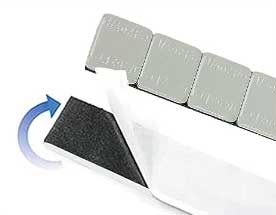

These weights come with adhesive backing strips, which makes it easy to stick to either the back of your guitar or the inside of your guitar’s cavity.
You can gradually add more and more weights and see how it affects the balance of your guitar and the amount of neck dive.
These weights are quite flat, which means if you stick them on the back of your guitar you shouldn’t notice them while playing.
Solution #4: Play a Headless Guitar
While this won’t solve neck dive on your current guitar, it is an excellent alternative if you’re regularly annoyed by neck dive.
Of course, headless guitars aren’t for everyone, but one of the benefits you’ll notice when you play one is how incredibly light and balanced they are.
As you can see in the below photo, my headless Ibanez Q52 has zero neck dive:

I knew headless guitars were light and balanced but I was still shocked the first time I picked up and played a headless guitar.
You can move the guitar in any position while standing, let go with your hands, and it will stay in place.
If you regularly play standing up and are looking for an option that doesn’t suffer from neck dive, try out a few headless guitars.
Solution #5: Use a Neck Dive Strap
A grippy strap and balancing weights is usually enough to reduce most neck dive. But there are some guitars that are so badly balanced that more drastic steps must be taken.
One method is to use a custom strap designed specifically to prevent neck dive.
There are two possible options to try out:
Option 1: Thigh Strap
I had to research this option when I built my triple neck guitar inspired by Steve Vai’s Ibanez Hydra.
As you can imagine, a triple-neck guitar seriously suffers from neck dive and no amount of balancing weights or grippy guitar straps can fix it.
What did fix it for me was adding a second strap to the guitar that wrapped around my thigh.



In the above photo on the left, you can see a black strap wrapped around my right thigh. This strap is mounted to the back of the guitar and completely prevents the necks from diving.
You can see that I’m still using a traditional shoulder strap, but as soon as I add the thigh strap, the neck dive issue disappears.
While I made my own thigh strap from scratch, you can buy one here.
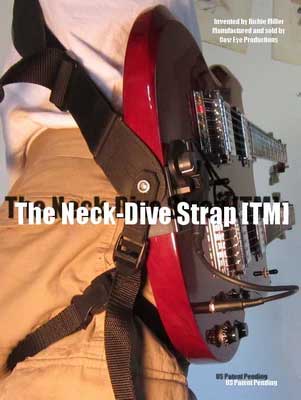

As you can see in the above photo, the Neck-Dive Strap wraps around your leg and attaches to the guitar’s end pin. So you’re able to use a strap like this without having to drill extra holes in your guitar.
If you have a Gibson SG, a double-neck guitar, or any other guitar that is known for serious neck dive issues, this method is worth considering.
While it doesn’t feel completely comfortable having a strap wrapped around your leg, it might be the best option depending on your guitar. With my triple-neck guitar, it’s the only way I can play it standing up.
Option 2: Belt Clip
The other option is to clip your guitar strap to your belt. Guitarist and YouTuber Fran Blanche explains this method in the below video (skip to 2:20 for a closer look at the strap):
It’s a simple solution to an annoying problem and works perfectly if you usually wear a belt.
The basic idea is to fix a clip onto your strap so it can slide up and hold onto your belt while standing.
If you want to try this method, I suggest using a belt clip like this one.
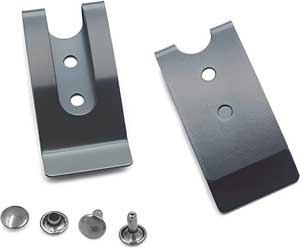

Belt clips are cheap and only require you to add a couple of positioning holes on your guitar strap.
I’d buy a cheap strap to test this method out before you consider adding holes to your strap. It may take a few attempts to figure out the best placement for the belt clip.
You can see how effective this method is in the YouTube video, so if you have a guitar with bad neck dive that you can’t easily fix with a normal strap or balancing weights, try using a belt clip.
Solution #6: Change the Strap Button Positions
I suggest this only as a last-resort option. Changing the position of the strap buttons physically damages your guitar.
If you don’t like the new positions you create, you’ll end up with ugly holes in your guitar. Please try all of the above methods before you even consider this method.
The idea with this method is that by changing the position of your strap buttons or pins, you can try and rebalance your guitar into a position that doesn’t cause as much neck dive.
As an example, my Ibanez Q52 has two strap buttons on the end of the guitar to choose between different playing positions:
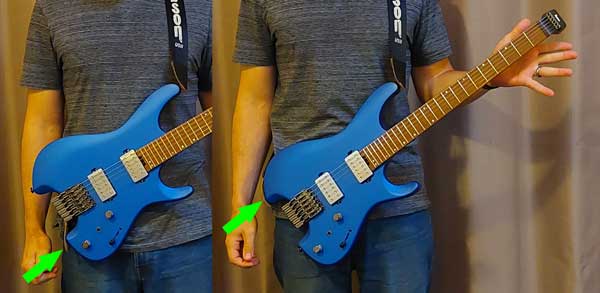

While this guitar doesn’t have any neck dive in either position, the change of strap position did make an obvious change to how the guitar felt while playing.
Remember that a guitar has two strap pins, so you have two possible ways to shift the mounting position.
There’s no easy way for me to suggest where you should move the strap button position because every guitar is different.
Look at the edge and back of your guitar for possible mounting positions and think about how it might change the balance of the guitar.
Unfortunately, there’s no good way to know what position will work before you drill a new hole, so I’d only consider this on cheap or worn-out guitars that you don’t plan to sell in the future. Please don’t ruin your expensive guitars using this method.
Which Solution is Right for You
There isn’t a one-size-fits-all solution to guitar neck dive because every guitar is different. Some guitars have heavy headstocks, while other guitars have awkward strap button positioning.
Adding weights to a guitar’s control cavity may be the best solution for some people, but other people may find that simply changing the type of guitar strap is all that is needed.
Try starting with the above methods that don’t physically modify your guitar. Before you drill holes to change strap button positions or add weights to your guitar, it makes sense to start with something less destructive.
Buying a wide leather or suede strap is the recommended first thing to try to fix neck dive. It fixes neck dives on a lot of guitars and you’ll most likely find it more comfortable to use (especially on heavy guitars).
